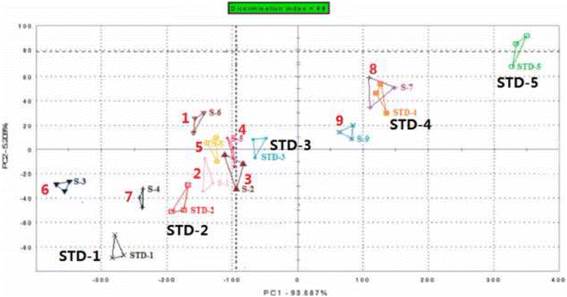Bitterness and antibacterial activities of constituents from Evodia rutaecarpa
- PMID: 28356098
- PMCID: PMC5372309
- DOI: 10.1186/s12906-017-1701-8
Bitterness and antibacterial activities of constituents from Evodia rutaecarpa
Abstract
Background: Bitter herbs are important in Traditional Chinese Medicine and the Electronic Tongue (e-Tongue) is an instrument that can be trained to evaluate bitterness of bitter herbs and their constituents. The aim of this research was to evaluate bitterness of limonoids and alkaloids from Evodia rutaecarpa to demonstrate that they are main bitter material basic of E. rutaecarpa.
Methods: Nine compounds, including limonoids, indoloquinazoline alkaloids and quinolone alkaloids, were isolated, identified and analyzed by the e-Tongue. Additionally, the antibacterial activities of the nine compounds were evaluated against E. coli and S. aureus.
Results: All the nine compounds had bitter taste and antibacterial activities to some extent. Among them, limonoids, which were the bitterest compounds, had greater antibacterial activities than alkaloids. And there is a positive correlation between bitter taste and antibacterial activities.
Conclusions: It was confirmed in our study that limonoids, indoloquinazoline alkaloids and quinolone alkaloids are main bitter material basic of E. rutaecarpa based on two evaluation methods of e-Tongue and antibacterial experiment. In addition, the e-Tongue technique is a suitable new method to measure bitter degree in herbs.
Keywords: Antibacterial activity; Bitterness; Electronic Tongue; Evodia rutaecarpa.
Figures
Similar articles
-
Quinolone alkaloids with antibacterial and cytotoxic activities from the fruits of Evodia rutaecarpa.Fitoterapia. 2013 Sep;89:1-7. doi: 10.1016/j.fitote.2013.04.007. Epub 2013 May 4. Fitoterapia. 2013. PMID: 23651559
-
New alkaloids from the leaves of Evodia rutaecarpa.Nat Prod Res. 2016 Oct;30(19):2154-9. doi: 10.1080/14786419.2016.1146888. Epub 2016 Feb 29. Nat Prod Res. 2016. PMID: 26923350
-
Quinolone alkaloids from Evodia rutaecarpa: a potent new group of antimycobacterial compounds.Int J Antimicrob Agents. 2005 Sep;26(3):262-4. doi: 10.1016/j.ijantimicag.2005.06.003. Int J Antimicrob Agents. 2005. PMID: 16051468 No abstract available.
-
Evodiamine: a novel anti-cancer alkaloid from Evodia rutaecarpa.Molecules. 2009 May 18;14(5):1852-9. doi: 10.3390/molecules14051852. Molecules. 2009. PMID: 19471205 Free PMC article. Review.
-
Major Indole Alkaloids in Evodia Rutaecarpa: The Latest Insights and Review of Their Impact on Gastrointestinal Diseases.Biomed Pharmacother. 2023 Nov;167:115495. doi: 10.1016/j.biopha.2023.115495. Epub 2023 Sep 21. Biomed Pharmacother. 2023. PMID: 37741256 Review.
Cited by
-
Antibacterial and Antifungal Terpenes from the Medicinal Angiosperms of Asia and the Pacific: Haystacks and Gold Needles.Molecules. 2023 May 4;28(9):3873. doi: 10.3390/molecules28093873. Molecules. 2023. PMID: 37175283 Free PMC article. Review.
-
Traditional Chinese medicine Euodiae Fructus: botany, traditional use, phytochemistry, pharmacology, toxicity and quality control.Nat Prod Bioprospect. 2023 Feb 15;13(1):6. doi: 10.1007/s13659-023-00369-0. Nat Prod Bioprospect. 2023. PMID: 36790599 Free PMC article. Review.
-
Disruption of Bacterial Thiol-Dependent Redox Homeostasis by Magnolol and Honokiol as an Antibacterial Strategy.Antioxidants (Basel). 2023 May 30;12(6):1180. doi: 10.3390/antiox12061180. Antioxidants (Basel). 2023. PMID: 37371909 Free PMC article.
-
Advances and mechanisms of traditional Chinese medicine and its active ingredients against antibiotic-resistant Escherichia coli infections.J Pharm Anal. 2025 Feb;15(2):101117. doi: 10.1016/j.jpha.2024.101117. Epub 2024 Oct 2. J Pharm Anal. 2025. PMID: 40026356 Free PMC article. Review.
-
A compound plant extract and its antibacterial and antioxidant properties in vitro and in vivo.3 Biotech. 2020 Dec;10(12):532. doi: 10.1007/s13205-020-02529-2. Epub 2020 Nov 13. 3 Biotech. 2020. PMID: 33214979 Free PMC article.
References
-
- Pharmacopoeia NCoC: Pharmacopoeia of the People's Republic of China. Beijing: Chemical Industry Press; 2010.
MeSH terms
Substances
LinkOut - more resources
Full Text Sources
Other Literature Sources
Medical





